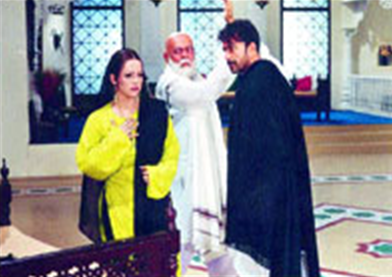Cinema : Pakistan
This is a collection of articles archived for the excellence of their content. Readers will be able to edit existing articles and post new articles directly |
History Of Cinema In Pakistan
By Qasim A. Moini
Film-making is not a cheap undertaking, nor is it easy. It requires money, time, passion and a whole lot of sweat and blood. If you’re willing to accept the challenge, face rejection and deal with loads of pressure, the field is wide open for local independent film-makers. Here’s to hoping a new breed of visionary film-makers take up this challenge and usher in the age of the Pakistani digital feature film
Every now and then, noises are made by pundits of various persuasions concerning the death, rebirth and fragile existence of Pakistani cinema. Matter of fact, the number of times local cinema has died, been close to death, been miraculously resurrected and then again marked for death would put the mighty phoenix — that mythical bird of antiquity — to shame. Consider this article one more voice in this boisterous cacophony.
However, this is not a charge-sheet against the forces responsible for the current state of affairs. Nor does this article offer any silver-bullet solutions to resurrect and breathe eternal life into Pakistani cinema’s decaying corpse. It is simply the thinking aloud of this writer regarding what can be done, as an alternative, to stem the rot. As always, there’s no guarantee for success, but what’s the harm in trying?
What I’m about to write might seem drastic. But drastic times call for drastic measures. And with one brief look at the Pakistani film industry, one can gauge something is wrong. Very wrong. Lollywood — as the Lahore-based cinema industry has been rather originally named — has been slowly descending into creative oblivion for the past three decades. Many reasons have been given for this, including but not limited to the strictures put in place on film-makers during Gen Ziaul Haq’s martial law; the decrepit state of cinemas; competition from VHS, VCD and now cable; to the invasion of the studio system by uncouth, semi-literate and rowdy elements who are now the ones supplying the cash needed to produce films.
What is the root of the malaise? Perhaps all of the above. And then some. But every few years or so, a film is heralded as ‘the next big thing,’ that will supposedly be the saviour of the Pakistani industry, delivering Lollywood to the promised land of healthy box office returns. These films (e.g. Choorian, Inteha, Yeh Dil Aap Ka Huwa and most recently Majajan) come and go, yet the stagnant situation does not change an iota. In the meantime, more and more cinema houses turn into garish shopping malls or parking lots. What are the solutions offered? Bring the industry to Karachi; induct more ‘educated’ people from ‘good’ families; improve the state of cinema houses.
Oh yes, and make better films. That little detail always seems to fall by the wayside.
Good films. Two very simple words, yet so difficult to translate into reality. How does one make a good film? Well, if the answer was that easy, there’d be an auteur waiting in every lane of every city in this wonderful land, from Karachi to Khyber. But there are some important details that if attended to, might pave the way for the production of good films. But before we get to those details, one preliminary step is required. Let’s all make a clean break from Lollywood, for the moment at least. Pretend it never existed. Think of it as a bad dream detached from reality. There. Now that that’s done, we can start with a clean slate.
The first requirement of a good film is an engaging story. For every film-maker — whether dramatic or documentary — is in essence a storyteller. And a good story is normally one you can relate to. I don’t know about you, but dancing around trees with buxom village belles, gandasas-a-thundering, guns-a-blazing, is not something I, personally, can relate to.
Our country is a cultural melting pot of ancient civilizations, languages and customs. Add to this the challenges of 21st century urban life, and you’ve got stories coming out the wazoo. Then what’s the issue? Why the same old tired tales repeated ad nauseum, badly acted out and shabbily produced? That’s a question better answered by the ones currently in the driving seat of the local industry.
Once we get our act together with regards to selecting engaging stories for screenplays, there appear further complications of technique, logistics and budget. I’ll say a few words on each of these fairly hairy topics. Whereas logistics and budget pretty much go hand-in-hand, we’ll have to get a little metaphysical where technique is concerned. You see, any yahoo businessman with a few crore rupees to throw around (we won’t get into the ethics of how these crores were made) can provide the considerable amounts of cash required to make a formula flick, the creative value/artistic merit of which is worth little more than that of chopped liver. That’s how Bollywood sustains itself. But the technique required to be a film director comes from above.
Indeed every child who goes to school learns to read and write. But not every child is a writer. That is Providence’s department: whom to bless with what skill. Hence, anyone who wants to become a film director can read all the books s/he wants, attend the finest courses higher education has to offer and even have a director’s chair made with his/her name stitched on the back. It does not matter one bit unless that person has the heart, passion and vision to be a director. For directing films is not your regular 9 to 5 schlep. One can learn the basics of film-making, but unless you possess that extra zeal, the kind that makes you wake up in the middle of the night to scribble down that line of perfect dialogue, that incredible fantasy sequence or that camera angle which is sure to make the scene, you’re better off appreciating films from the comfort of your favourite armchair.
But that’s not to discourage anyone. Rather, it is my sincere wish that new, young and talented Pakistani directors-in-waiting take up the challenge. And the best way to sort out the men from the boys is to encourage people to make films. Good, bad or ugly, go out and make films. With time, refinement and panache will come. A Coppola or Kiorastami comes along once in a lifetime; as for the rest of us, the best way to hone our film-making skills is to practice. Start with a handycam if necessary. Then work your way up once you gain both experience and the requisite funds to shoot your dream picture. Which brings us to the other set of hairy issues related to film-making: logistics and budget.
Nearly every director worth his salt the world over wants to shoot his/her feature film on 35mm film stock. However in Pakistan, it would not be an exaggeration if one suggested that the number of directors who have the logistics, skill and budget to shoot, process and edit a movie shot on film can be counted on one hand.
Film stock is bloody expensive and one does not have the luxury to goof around on location. Once the camera is rolling, that’s money (lots of it) flowing like water. There is no such-thing as a ‘low-budget’ picture shot on film, for even the least expensive, most thrifty 16 or 35mm films run into thousands of US dollars, dollars the average, middle-class Pakistani aspirant film-makers can ill afford. So what to do? Go digital.
Though diehard devotees of film will decry video as an inferior format not worthy a second look, the truth of the matter is that though video cannot (yet) match film in picture quality and depth of image, video has brought film-making to the people. For the most part, it has made film-making a more egalitarian pursuit. For independent film-makers, the DV (digital video) format has come as a Godsend. With digital, production and post-production costs have been slashed, and with the development of high definition (HD) formats and the impending arrival of the much trumpeted ‘Red One’ camera (digitally able to beat even film’s picture quality, according to its makers), the tide is turning. Of course, film’s defenders will beg to differ.
Local film-makers need to forget their fixation with film and aim towards making digital features. A Mini DV tape costs around Rs500-600 in the market. With tape, you can record over and over again, whereas once a roll of film is shot, it cannot be used again. I won’t get into the technical specifications of film vs video, as I want to keep this article as general as possible, but it’ll be enough to say that though film’s picture quality is still far superior to video, video is fast catching up and its cost-effectiveness makes it ideal for independent Pakistani film-makers. And if it’s any consolation, more and more Hollywood blockbusters are being shot on digital.
Some of the more recent films include Superman Returns and Miami Vice, while Star Wars Episodes II and III were both shot on HD. Admittedly, these were shot on high-end HD cameras that cost US$100,000 plus, but decent HD cameras can be had for between US$8,000-$15,000. As for semi-professional DV cameras, they can be acquired for between US$2,000-3,000. But what it comes down to is that unless your screenplay is a sure-fire winner, you can shoot on anything you want, it simply won’t draw an audience.
Even the above-mentioned amounts are not chump change. Film-making is not a cheap undertaking, nor is it an easy undertaking. It requires money, time, passion and a whole lot of sweat and blood. If you’re willing to accept the challenge, face rejection and deal with loads of pressure, the field is wide open for local independent film-makers. Here’s to hoping a new breed of visionary film-makers take up this challenge and usher in the age of the Pakistani digital feature film.
Pakistani cinema and Bollywood
The Times of India, Feb 21 2016
Sameer Arshad The effective ban on Sonam Kapoor's film `Neerja' in Pakistan is the latest fallout of seesawing Delhi-Islamabad ties. The biopic on air hostess Neerja Bhanot, who was killed while saving lives of passengers including Pakistanis onboard a hijacked flight in Karachi in 1986, would not be screened in Pakistan for its “negative portrayal“. Earlier similar reasons were cited for banning films like `Phantom'. That the bans do not work and robbed Pakistan of a major source of revenue had forced Islamabad to lift a blanket ban on Bollywood films in 2007. The ban was imposed following the 1965 war, but it became ineffective starting 1980s when film buffs began smuggling VHS tapes to watch Indian movi es. Satellite, cable TV and DVD piracy made the embargo even more pointless, prompting reconsideration of the ban to tap into crucial revenue that was otherwise going to underground piracy industry.
Pakistan is believed to have emerged among five top markets for Bollywood since `Goal' in 2007 became the first Indian film to be screened there in 42 years. The screening of Bollywood movies has since been credited with reviving cine-going culture, fueling multiplex boom and revitalizing Pakistan's decaying film industry.
Upper and middle-classes had virtually stopped going to cinemas due the proliferation of vulgar Punjabi movies like `Maula Jatt,' which were a hit with working classes and peasants empowered during socialist Bhutto era in the 70s. Before 2007, old cinemas were being razed to make way for malls as they made no business sense. Businesses were reluctant to invest in new halls, where the middle and upperclass families could go.
Super Cinema has pioneered the multiplex boom in Pakistan while multinational IMAX launched its first theater in Lahore in 2014 with the screening of `Transformers: Age of Extinction'.IMAX had earlier collaborated with Cine Star Cinema to install digital theaters in Lahore, Islamabad and Karachi in 2012. Even a small town like Gujranwala has at least six multiplexes.
Pakistani cine goers have since 2007 mostly lapped up Indian movies at these multiplexes. In December 2015, `Dilwale' was reported to have earned around Rs 5 crore on the first day of screening, making it the most successful film in Pakistan. `My Name Is Khan' was a super hit in Pakistan in 2010 before it could be released in Mumbai as Shiv Sena stalled its release there following Shah Rukh Khan's statement regretting exclusion of Pakistani cricketers from IPL.
The supporters of Bollywood movies argue they have led to the revival of Pakistani films like `Khuda Kay Liye' by reviving cine-going culture and creating demand for good local content. The number of privately-owned TV channels in Pakistan went up to over 50 in 2008 compared to three state-run channels six years back. The small screen offered new opportunities for actors, filmmakers and technicians.
Shoaib Mansoor's `Bol' in 2011 was a product of this revival and dealt with sexuality. It was the first Pakistani movie to make $1m at the box office. Bol has inspired many films of international quality like Zinda Bhaag, which became the first Pakistani film to be nominated for Oscar in 50 years in 2013.



